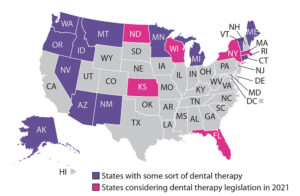 GECKOPHOTOS/ISTOCK/GETTY IMAGES PLUS
GECKOPHOTOS/ISTOCK/GETTY IMAGES PLUS
Update on Dental Therapy in the United States
The expansion of dental therapy continues across the nation as a solution to increasing access to care for underserved populations.
The Minnesota legislature authorized dental therapists in 2009. Today, there are 113 licensed dental therapists practicing in Minnesota, many of whom are dually licensed as dental hygienists. Two dental therapy education programs are educating future dental therapists in Minnesota, and there is speculation that another program may be started, as well. Let’s take a look at where dental therapy is headed and what states should consider as dental therapy progresses across the country (Figure 1).
Choice and Competition
In 2018, the United States Department of Health and Human Services (HHS), Department of the Treasury, and Department of Labor, in collaboration with the US Federal Trade Commission and the White House Presidential Departments, issued “Reforming America’s Healthcare System Through Choice and Competition.”1 The report contains state and federal policy recommendations to improve choice and competition in the healthcare sector. Notably, the report says, “Emerging healthcare occupations, such as dental therapy, can increase access and drive down costs for consumers, while still ensuring safe care. States should be particularly wary of undue statutory and regulatory impediments to the development of such new occupations.” The report recommends, “States should evaluate emerging healthcare occupations, such as dental therapy, and consider ways in which their licensure and scope of practice can increase access and drive down consumer costs while still ensuring safe, effective care.”1
Currently, dental therapy has been authorized in Minnesota, Maine, Vermont, Arizona, Michigan, New Mexico, Nevada, and Connecticut. In addition, Washington, Idaho, and Montana have authorized dental therapists to practice on tribal lands. Dental therapists provide services on tribal lands in Alaska, too. Oregon has created a pilot project to allow dental therapists, and the legislature is expected to consider providing permanent authorization in 2021.

What’s Ahead in 2021
As we look forward to the 2021 state legislative session, we anticipate that nine states will be deliberating dental therapy legislation. These include Florida, Kansas, Massachusetts, New York, North Dakota, Oregon (to provide permanent authorization), Washington (to include the entire state), and Wisconsin.
The American Dental Hygienists’ Association (ADHA) has policies that are predicated on the development of workforce models that culminate in graduation from an accredited institution, professional licensure, and direct access to the patient. Sounds simple enough. As more and more states work to pass legislation authorizing dental therapy, I am hopeful that the work of the earlier states will lighten the load and pave the way forward.
The Playbook
As more states consider legislation to authorize dental therapy, they will benefit from several advancements that have taken place and resources that are now available.
- The Commission on Dental Accreditation (CODA) adopted the Accreditation Standards for Dental Therapy Education Programs in 2015. Adoption of these standards formalized the designation “dental therapist” for this newly created provider. Prior to that, many states entertained any number of names for this new provider.
- CODA acknowledges and provides for “advanced standing” for dental hygienists who desire to enter a dental therapy education program. That is both appropriate and critical to provide a potential career pathway for dental hygienists. Statutory language need not and should not dictate what professions may enter into a dental therapy education program.
- In August 2020, Iḷisaġvik College’s Alaska Dental Therapy Educational Program became the first dental therapy educational program to receive CODA accreditation. That pinnacle moment provided a new level of legitimacy and credibility to the dental therapy movement.
- A multi-agency federal report issued in 2018 recognizes dental therapy as a means to improve choice and competition in the oral healthcare sector. Dental therapy is largely a nonpartisan issue, and any advocacy strategy should consider that.
- There is no reason to reinvent the wheel. Tremendous resources are now available to states and potential employers including a dental therapy tool kit developed for the Minnesota Department of Health through a partnership between the University of Minnesota School of Dentistry, Metropolitan State University/Normandale Community College, and MS Strategies.2 The toolkit includes information for states and potential employers.
- The University of Minnesota School of Dentistry, Metropolitan State University/Normandale Community College, and MS Strategies have created a website to answer the most commonly asked questions that dentists—as potential employers of dental therapists—have when considering what it would take to include a licensed dental therapist as part of their practice team, regardless of whether their clinic is located in a remote rural area, a densely populated inner-city area, or a suburban community.3
- State laws that place arbitrary limitations on where dental therapists may practice are not based on evidence. Such limitations are unnecessary and continue to create barriers to accessing care.
Statutory language need not and should not dictate what professions may enter into a dental therapy education program.
Conclusion
While the expansion of dental therapy is certainly exciting, there is much more work to be done. The American Dental Hygienists’ Association advocates for the broadening of opportunities for dental hygienists and works on strategies to increase access to care for our nation’s most vulnerable populations. Visit adha.org for information on how you can make a difference in your state.
References
- United States Department of Health and Human Services. Reforming America’s Healthcare System Through Choice and Competition. Available at: hhs.g/v/sites/default/files/Reforming-Americas-Healthcare-System-Through-Choice-and-Competition.pdf. Accessed November 11, 2020.
- University of Minnesota School of Dentistry, Metropolitan State University/Normandale Community College, and MS Strategies. Dental Therapy Toolkit: A Resource for Potential Employers. Available at: health.state.mn.us/facilities/ruralhealth/emerging/dt/docs/2017dttool.pdf. Accessed November 11, 2020.
- Metropolitan State University/Normandale Community College, University of Minnesota School of Dentistry. Hiring a Dental Therapist or an Advanced Dental Therapist. Available at: mchoralhealth.org/mn/dental-therapy/. Accessed November 11, 2020.
From Perspectives on the Midlevel Practitioner, a supplement to Dimensions of Dental Hygiene. November 2020(12):28-30.

